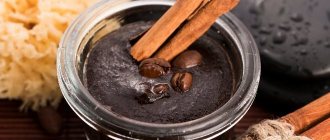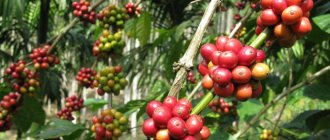For many of us, the morning begins with a cup of aromatic coffee. The dried grounds are often used as a scrub to cleanse the skin of the face and body. But there are other uses for coffee grounds. Experienced gardeners know that there is nothing better than natural fertilizers. Therefore, coffee grounds are successfully used as fertilizer. Is this method justified? Let's look at the pros and cons.
Benefits of coffee for plants
Ground coffee and boiled coffee grounds have been used for cosmetic purposes for many years. There are recipes for making face and body scrubs, tonic lotions, masks, and creams. But few people know that coffee can also be used in gardening.
Coffee beans are rich in microelements: Mg (magnesium), Ca (calcium), P (phosphorus), N (nitrogen), K (potassium). Phosphorus and potassium improve the ovary and yield of crops, and nitrogen takes an active part in photosynthesis, which will accelerate the development of the plant. Spent coffee will be useful not only for indoor and garden flowers, but also for garden crops.
Spent coffee can be used as fertilizer, regardless of the method of preparation.
The amount of useful substances is about 3% of the total volume. Therefore, coffee grounds cannot completely replace fertilizers, but they can be used as additional fertilizing.
Previously, I thought that coffee cake was only suitable for soil with an alkaline environment, since it has a fairly high level of acidity. But actually it is not. Research by scientists has shown that spent coffee has a neutral pH level. And the acid contained in whole grains is washed out when they are cooked.
From my own experience, I can note that coffee grounds help increase the yield of eggplants, carrots, radishes and tomatoes. Berries and fruit trees respond well to coffee fertilizing. Also, I noticed an increase in the number of buds and more luxuriant flowering of roses, lilies and begonias.
Another advantage of coffee fertilizing is its aromatic smell, which repels many pests, but, on the contrary, attracts earthworms, which contributes to better soil aeration.
As a natural dye
Coffee cake can be an excellent natural dye for Easter eggs
Coffee cake is a natural, environmentally friendly dye. It can be used to dye Easter eggs, fabric or paper. Coffee gives a noble brown tint. You need to pour the grounds with a small amount of hot water and leave for several hours. Next, dip eggs or cloth into the solution and leave for a few more hours. At the end of the procedure, the eggs are wiped with a soft, dry cloth, and the fabric is allowed to dry naturally.
By dipping the paper into the solution, you can make “antique parchment” with uneven, but very beautiful brown stains of varying intensity.
You need to keep it in the liquid for no more than a few seconds, otherwise it will become limp.
This is the best idea for decorating or making vintage cards with your own hands.
What are the benefits of coffee grounds?
Coffee is more than just a dose of caffeine packed into a small cup. Most people, after drinking espresso or cappuccino, get rid of the grounds by throwing them in the trash. According to statistics, each person drinks 300-500 cups of coffee per year.
Assuming that we put a heaping teaspoon of coffee or 10 g into 1 cup, everyone throws out 3-5 kg of grounds annually. Before you throw away the grounds next time, you should think about how they can be reused in the garden, vegetable garden, or for plant nutrition.
How to use against wasp and fly infestations
You can scare away wasps if you pour a handful of ground coffee into a heat-resistant container, set it on fire, and then put it out.
Annoying insects cause discomfort by staying not only on the site, but also by flying into the house. They will leave these places if you set fire to the cake in the places where they accumulate. The second method is to place tin cans around the perimeter of the area where the wasp nest was found, pouring a mixture of cake and saltpeter into them (10 g of saltpeter per 200 g of powder). Next, you need to set the mixture on fire, it burns at an average pace. The procedure is carried out with caution; do not inhale the combustion products of nitrate - they irritate the mucous membrane of the respiratory tract. This fumigation is done infrequently, the effect lasts for 2 weeks.
Effect of coffee residues on plants
Unlike other similar fertilizers, nitrogen taken from coffee is not absorbed as quickly by crops. For example, fertilizing tomatoes takes a certain time. The chemical element becomes active only after the decomposition of microorganisms and bacteria in the soil.
Those who hope for a positive result with natural fertilization of crops should remember that its slow activation can play a negative role, because gardeners think not only about nitrogen, but also about phosphorus and potassium. Squeeze is rich in these elements in approximate proportions:
Coffee contains magnesium and copper, and calcium, zinc, manganese and iron become available after decomposition.
Many people believe that using coffee grounds in the garden leads to increased soil acidity, but almost all chemical compounds dissolve during brewing. Subsequently, a neutral acid-base balance is created, and the soil becomes a favorable environment for vegetables.
Cake for the garden
The role of coffee grounds as fertilizer in aerating the fertile layer and protecting against slugs is irreplaceable. The powder composition attracts earthworms, but is undesirable for slugs and snails. Also, red ants and rabbits do not like coffee: they leave the area.
To repel ants from the area, you need to sprinkle dry powder on the paths or sprinkle coffee substrate on the anthill. To repel aphids and slugs, plants are sprayed with a liquid solution.
If you need to protect your garden beds from cats, sprinkle them with a mixture of coffee grounds and orange zest.
Tomato seedlings respond well to coffee fertilizer. For tomatoes, the cake is used throughout the growing season. Thanks to the attraction of beneficial soil microorganisms and the formation of bacterial strains, the fertile layer is enriched with essential nutrients.
For berry bushes, cake is used as follows. You need to scatter 2-3 cups of dry substrate around the roots and water them with water. And when planting a young seedling, place three to four cups of dry fertilizer in the hole and water it. The cake is pre-mixed with the soil.
Note! An important property of dormant coffee is the delay in the accumulation of nitrates in vegetable fruits.
Mulching with thickets protects garden flowers and fruit trees from slugs and other parasites without the use of chemicals. Caffeine acts as a poison on pests and destroys their population. Also, the smell of coffee repels insects and other unwanted “guests” in the garden. However, it is recommended to mix the cake with soil so that it does not form a dense film around the trunk, preventing air permeability.
Cake composition
For people, the coffee drink is not of great value, but for plants it is a concentration of beneficial microelements. Potassium, phosphorus, nitrogen, copper - these important substances strengthen plant health and provide nutrition.
There is as much nitrogen in the cake as in rotted weeds. This is a very high figure, because crops need nitrogen for active vegetation.
Phosphorus, the content of which in coffee is quite sufficient for the development of crops, improves flowering and fruit set. Phosphorus is also indispensable during the formation of roots and improves the taste of fruits.
In addition to the listed elements vital for crops, coffee powder also contains other important minerals and trace elements.
- enrichment of the fertile layer with microelements;
- protection from certain types of pests;
- improving soil texture inexpensively;
- attracting soil microorganisms and earthworms;
- savings on the purchase of agrochemicals.
Some gardeners believe that with regular use of coffee fertilizer, agrochemicals are not needed at all. However, it is necessary to take into account the structure of the soil and its characteristics, because certain garden crops require a certain acidity of the fertile layer.
Can raw ground coffee powder be used as fertilizer? No, it is the coffee that is needed to feed the plants, otherwise it can harm the plants instead of benefiting them. The dried powder contains no acid, which is harmful to many crops.
As practice shows, not all seedlings like the coffee aroma. Gardeners have noticed that in areas where alfalfa and clover grow, it is better not to add grounds. Geraniums, cacti and succulents do not like coffee fertilizer.
Preparing the Coffee Grounds
To prepare the fertilizer, you must use only used, that is, boiled coffee. Ground but not boiled grains have too high acidity, which can change the overall pH level of the soil, negatively affect the development of crops, and even lead to their death. For the same reason, I do not recommend pouring leftover liquid coffee under the plants.
The coffee grounds must first be dried. To do this, spread it in a thin layer on parchment paper, you can use an old sheet or towel, and leave it for a couple of days.
Only well-dried coffee can be used as fertilizer.
You can also use the oven to dry it, this will speed up the drying time, but you need to be careful not to overcook the coffee grounds. Raw or poorly dried coffee can quickly become infected with fungus, which can cause disease in the plants.
It is advisable to store coffee grounds after drying in a tightly closed container to avoid moisture and prevent the aroma from fading.
From cats and dogs
Cats also don’t like coffee, and if your pet relieves itself in the wrong place, then after you clean and wash this place, sprinkle it with coffee.
Pets and random guests in your garden - cats and dogs - are capable of digging holes and destroy the first sprouts of seedlings, as well as “mark the territory.” To keep them at a distance, you can prepare a special mixture.
Dry coffee cake is mixed with 1-2 drops of rosemary or orange oil, or chopped citrus zest. This mixture is laid out in a thin layer where the animal’s paw should not tread.
How to use grounds in the garden
It can be mixed with plant seeds (carrots, beets), this will speed up germination. A mixture of soil and dry coffee substrate is placed in planting pots for seedlings; this soil mixture gives excellent results. The seedlings grow strong and can easily be transplanted into holes.
You can also scatter the substance around the rooted seedling, which will facilitate an increase in nitrogenous substances in the fertile soil layer after each watering.
Note! If you set fire to a handful of cake in the house, all the flies and mosquitoes will fly away.
Fertilizer can be buried to a depth of about 4 mm. This method will retain moisture after watering and provide an influx of oxygen into the soil.
When planting, use compost with grounds mixed with the fertile layer in half. This will provide the seedlings with the necessary nutrition.
Also, dry grounds are simply diluted with water and irrigated green spaces.
Improving the mechanical properties of soil
Spent coffee is used as a fertilizer in the country to improve the mechanical characteristics of the soil. The soil texture is improved by the biological elements of the grounds. It is especially useful to use cake on soils of heavy texture - clayey, loamy. On sandstones, coffee cake reduces acidity, which has a beneficial effect on the composition of the fertile layer.
Note! Coffee protects the garden from weeds.
However, if you regularly use cake for mulching, the soil layer can become compacted and begin to impede air permeability. Therefore, mix the substrate with fertilizers of a larger fraction.
How to use grounds to improve soil and control pests
Spent coffee grounds are widely used in the country: in the garden, vegetable garden and greenhouse. Experienced gardeners use it:
1. For mulching plantings.
2. For light acidification of the soil.
3. To improve the mail structure. Adding dried coffee to the soil mixture makes it more airy and lighter. At the same time, it is important not to pile coffee grounds in a thick layer around the plants, otherwise they can cause the appearance of a dense soil crust that prevents free access of air and moisture to the root system of the plants.
4. In addition, coffee grounds can be used to make compost, which can later be used to grow flowers, vegetable seedlings and mushrooms. To prepare it, you need to put the following in a compost pit specially designated for this purpose:
Attention! If desired, you can also add some leaves, pine needles, bone meal, and even cardboard or paper to the mixture.
All components must be mixed well, sprinkled with soil and water on top, and then use a stick to make several holes in the pile. Useful compost will be ready for use in just 4-6 weeks. During this period, you should ensure that the pile is always wet.
5. To get rid of ants and snails. Ants cannot stand the coffee aroma and will disappear from the greenhouse if you sprinkle coffee on their nests. The same applies to snails - they will stop annoying plants if you sprinkle coffee grounds on the soil around them.
6. To wean your cat from digging holes in the garden, you should use a mixture of crushed orange peels and drunk coffee. By scattering the fragrant mixture around the plants, you can be sure that the cat will not make a toilet in the beds.
Areas of use
Coffee grounds can be useful in many places.
Getting rid of pests in the garden
The remainder of the ground coffee after consumption can be scattered on the beds or around fruit trees. This can help repel ants, slugs and snails. Often, pets choose planting beds and the ground around plants and plantings in the garden to go to the toilet. Coffee grounds mixed with orange zest or rosemary oil will relieve them of the desire to relieve themselves in a place unfavorable for the owner. In addition, coffee powder repels insects. If you set it on fire, you can get rid of annoying flies and wasps.
Important! Coffee cake can control pests not only in the garden. It can be rubbed into the fur of an animal that is tormented by fleas. They cannot stand the smell of coffee.
Fertilizer for plants
Coffee fertilizer is perfect for plants that grow in an acidic environment. Excess acidity can be eliminated using a combination of coffee grounds and fallen leaves with dried grass.
This mixture is sprinkled on the ground around the flowers. Thanks to coffee grounds, the soil is better saturated with nitrogen, magnesium and potassium, which has a beneficial effect on plant health.
Adding tree resin or lime to the grounds will help saturate the flowers with calcium and phosphorus. This mineral fertilizer will help maintain a high level of flowering and fruiting of flowers.
Ways to use coffee residue:
- In the form of a mixture obtained by mixing coffee cake with warm water.
- As a single fertilizer.
- As part of complex additives.
Fertilizer for compost pit
Due to the high nitrogen content in coffee residues, the use of cake leads to good humus of greens. However, you need to take into account that there is no need to overdo it with adding grounds. But attracting beneficial worms to the compost pit would be quite appropriate.
Energy for carrots
Dried caffeine added to carrot seeds can give them energy. Thus, the product is of higher quality and the harvest is larger. In addition, with such fertilizer, plants will not be afraid of pests.
Getting rid of unwanted odors
Leaving coffee grounds in the refrigerator or freezer for a few days will do a great job of eliminating food odors. Caffeine perfectly absorbs food odors.
Cleaning surfaces
Coffee cake can be used to clean the surface of kitchen furniture. It perfectly removes dried food stains. However, remember that scratched surfaces must be handled with care. If the cake gets into the crack, stains will remain. The product itself cleans the surface gently and does not scratch.
Coloring agent
Caffeine, if not removed over time, can eat into various surfaces, leaving golden hues on them. This property can be used when dyeing fabrics or, for example, eggs for Easter. Plain paper can be made into a parchment base using caffeine diluted in water. This way you can design a hand-made postcard and realize any other fantasies.
A product that makes it easier to clean the fireplace
Used coffee beans can be used to fill the fireplace opening before cleaning it. This will allow the ash to settle and not rise while cleaning the fireplace. Thus, there will be less dust and dirt, and the cleaning process itself will be much easier.
Cosmetic procedures
Coffee leftovers can be excellent cosmetic products. They are used as:
- Body scrub. Coffee beans are mixed with body oil (preferably coconut) and applied to the skin of the body. This scrub has a high-quality exfoliating effect.
- Scrub for cleansing the skin on the face. You can use this recipe: mix coffee grounds and cocoa powder in equal proportions. Add cream or milk, a little honey to the resulting mass and stir the mixture. The resulting product is applied to the face for a few minutes, then washed off. It contains many essential minerals and antioxidants for the skin.
- Face masks. The coffee grounds are mixed with cream and applied to the face for about a quarter of an hour. Then the mask is washed off with cool water. The procedure eliminates double chin and tightens sagging areas on the cheeks.
- Hair and scalp care products. A coffee cake mask gives your hair extra volume and restores it after using styling products. After such a mask, the hair acquires a natural shine and looks healthy.
Method of use:
Before washing your hair, rub the remaining coffee into the skin between the strands, massaging the scalp. The structure of coffee beans is able to remove dead skin cells without causing harm to healthy hair follicles.
- Anti-cellulite product. Cellulite doesn't appear without a reason. As a rule, it is preceded by a genetic predisposition, a sedentary lifestyle, the presence of bad habits and a tendency to poor nutrition. There are many ways to cure the skin from this disease. Using leftover ground coffee can effectively solve the problem.
Method of use:
To do this, just rub a mixture of coffee grounds and warm water into problem areas several times a week for several minutes. If you regularly use this method, the skin transforms before your eyes, unevenness gradually disappears, and is replaced by smoothness and elasticity.
- Additives to massage oil. This additive enhances the effect of massage and promotes better relaxation of tight muscles.
Important! Coffee residue can restore the body's strength. To do this, it can be added to shower gel and rubbed into the skin of the body with massaging movements.
Nutritional value of coffee for plants
The amount of nutritional components in coffee grounds depends primarily on the preparation method. During vacuum cooking, most proteins, amino acids, potassium, and magnesium enter the water. With the Turkish method of preparing coffee, more nutritional components remain.
It is believed that caffeine inhibits the growth of crops, but after heat treatment there is little of it left in the cake, so coffee is used safely as a fertilizer for indoor plants.
Coffee is also used fresh. True, ground it contains a lot of active nitrogen, which, when decomposed, releases ammonia and can harm the root system.
Because of its ability to increase the acidity of the soil, ground coffee benefits plants that prefer low soil pH - rhododendrons, heathers, azaleas, hydrangeas.
After digestion, the pH level decreases several times, so there is no danger to plants. It is better to first soak ground coffee as a flower fertilizer in water, then spray or water it at the root.
Using coffee grounds to clean dishes
Ground coffee cake easily removes dirt, and dish soap will defeat grease.
Coffee cake is a soft abrasive that can restore the former shine to a metal sink, taps, pans and pots made of aluminum.
- 15 ways to use coffee grounds sustainably
A huge plus is that it does not scratch the surface like soda.
Directions for use: Place a small amount of powder on a sponge and clean the damp metal surface until shiny. A similar method is used to clean ceramics and even porcelain without gilding; the degree of grinding of the powder is important - the smaller the better.
Coffee grounds - benefits for vegetables
Due to its high potassium content, coffee cake is used for growing tomatoes, cucumbers, potatoes and other vegetable crops. If it is possible to get a lot of coffee residues somewhere, and these are cafes, restaurants, private stores, then you can make fertilizing for fruit trees. Fruiting next year will be better.
Flowering ornamental plants that need potassium, starting from the budding period, also respond to the introduction of coffee cake - used as mulch or by watering.
Coffee grounds are used not only for fertilizer. It attracts earthworms to the site, which help improve soil aeration, and also release coprolites rich in humic acids into the soil.
How to use coffee grounds to control insects
Coffee not only increases the acidity of the soil, it serves as a deterrent to pests. The cake repels snails, slugs and other inhabitants that interfere with the normal growth of garden and indoor plants. For prevention, it is scattered over the flower garden and vegetables. Spent coffee is mixed with orange peel and rosemary oil. Such scents do not attract cats or dogs.
Instant coffee against slugs
Dilute 2 tsp in a glass. coffee with hot water (a little cognac can be added there) or whiskey, cool and pour into a sprayer. Treat the cabbage with the prepared liquid. The worms die, but to prevent them from multiplying, you need to water the vegetables at least once a week. Inexpensive, finely ground coffee may be suitable for such purposes.
Some gardeners show curious ingenuity. Before scattering the seeds, coffee cake is mixed with them, and thanks to a little trick, carrots and radishes germinate faster than usual. For cultivation, gardeners use only pure extraction without additives:
Before use, summer residents advise rinsing the grounds to get rid of unnecessary fillers.
During the summer, summer residents put all organic residues in a compost heap or use them as fertilizer. In winter, as a rule, all food waste and coffee waste from the coffee machine go into the trash. But in the spring you can arm yourself with organic matter if you collect it.
Coffee delicacy for seedlings of tomatoes and peppers
Young shoots of garden crops become stronger and bear fruit better in the future when they are fed with organic waste. Just like coffee lovers, some plants need this treat.
Using coffee grounds
I’ll tell you about the popular uses of healthy compounds that can be easily prepared from coffee leftovers.
Coffee grounds compost
Adding coffee grounds to your compost pile is its most popular use. This free fertilizer is suitable for both garden annuals and garden perennials. The most successful composition: straw + dry leaves + coffee cake. I recommend sticking to the ratio 1:1:2.
This compost is used as usual:
- for mulching;
- for application to future beds;
- for fertilizing young plants during planting and replanting;
- for digging in - feeding adult plantings.
Coffee grounds mulch
Another useful use of coffee grounds is mulch. In this role, it is an environmentally friendly composition that is safe for cultivated plants. It is distinguished by the following properties:
- Prevents the evaporation of moisture from the ground and the growth of weeds in the beds.
- Allows elements to be released into the substrate faster.
- Enriches the soil in the garden with nitrogen.
- Attracts beneficial earthworms to the site.
- It looks aesthetically pleasing and natural not only in garden beds, but also in flower beds.
Using mulch is as easy as shelling pears: first dry the cake in the sun and spread it in a 2-3 cm layer on the surface of the ground. When using such mulch, I also take into account its disadvantages:
- Over time it may become moldy. To prevent this from happening, I thoroughly rinse the mass with water and dry it thoroughly.
- May attract ants and other sweet-toothed pests. It’s not the grounds themselves that are to blame here—many people drink it with sugar. To get rid of this disadvantage, it is again important to thoroughly rinse the cake.
Soil improver
And another useful application is improving the quality of the substrate on the site with the help of coffee additives. Their use is universal: soil that is too light begins to retain moisture, while soil that is too heavy, on the contrary, becomes more moisture- and breathable.
To achieve the desired effect, it is enough from time to time to add coffee cake to the upper layer of the garden substrate, and then dig up the soil.
How to Grow Greens in Coffee
Coffee cake itself is a good substrate for growing plants at home. Of course, using it in such a role for valuable seedlings is too risky, but as an experiment, for growing greenery on a windowsill, it is an excellent solution.
Remember that coffee cake does not contain all the nutritional and mineral components necessary for plant development. Therefore, it is important to fertilize your plantings with complex fertilizers in a timely manner.
Pest protection
And another useful use of coffee cake in the garden is protection against pests. Here's what I noticed while using it:
- Slugs and snails do not grow in a garden bed covered with coffee mulch. This covering is a serious obstacle to their delicate bellies.
- Coffee cake is an effective repeller of mosquito larvae, bedbugs and other unpleasant flying creatures.
- Coffee grounds (not sweet ones, of course) also repel ants. From time to time you need to sprinkle their passages and nests with cake.
- Carrot midges are also afraid of coffee. The dried cake is poured into the grooves with the seeds. The specific aroma of the grounds will repel pests.
- You can also save radish root crops from attacks by underground insects using cake. To do this, the seeds of the plant are planted in dried coffee pulp. This “wrapper” not only scares away uninvited guests, but also serves as a top dressing that stimulates the harmonious development of the plant.
Of course, I don't use coffee as the main "strike force" against insect pests. But as an “additional weapon” its use is not superfluous.
Coffee grounds are not useless trash. Its main use in the garden is as a natural nitrogen fertilizer. The grounds are also good as mulch, a component of compost, a means of improving soil structure and a repeller of uninvited guests.











